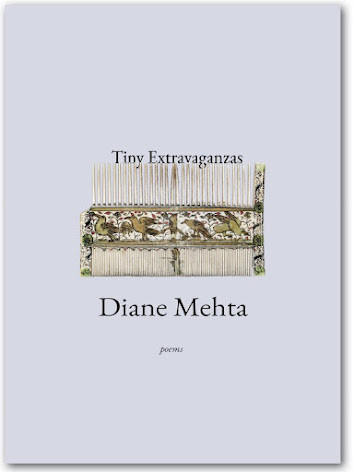Diane Mehta, Tiny Extravaganzas: poems
HEDGE MAN
The gardener climbs aladder, wiring floodlights
in to snip the darknessoff and save us.
We think we are so rich,below hedges
trimmed; we believe inGalileo because we telescope
objects of desire andconfirm their centrality.
We have lived here sincethe fourteenth century
We are kings of pencilshavings and paper
gaming high designs; weword-build
in Scrabble and weep overapocalypse letters
that won’t weave mechanivinto E or zock in O.
The floodlights swallowall the stars
we loved so much, butmade within its shimmer
spotlights of our faces, dissolvingbehind us
with words and shapes wemade at our tables,
knowledge in hand, believingwe are so rich.
 Iwas curious about
Tiny Extravaganzas: poems
(Medford MA: ArrowsmithPress, 2023), the first I’ve seen from poet Diane Mehta [see her 2019 ’12 or 20 questions’ interview here], a writer “born in Frankfurt, grew up in Bombay andNew Jersey, studied in Boston, and now makes her home in New York City.” TinyExtravaganzas is Mehta’s second published full-length collection, following
Forest with Castanets
(Four Way Books, 2019), as well as a poetics andstyle guide,
How to Write Poetry
(Barnes & Noble Books, 2005) andthe essay collection Happier Far (University of Georgia Press, 2025).I’m intrigued by the expansiveness of Mehta’s American lyric, one that bothcites and responds to Walt Whitman and his opening of lyric structure, as wellas her engagement with the ode, triolets, hymns, landscape descriptions andobjects of worship. “We lived in adverbs,” the poem “ODE TO PATRICK KEARNS,FUNERAL DIRECTOR / OF THE LEO F. KEARNS FUNERAL HOME IN QUEENS” writes, “dressedfor rainshine / half the time and not according to the daily toll, not thisrunning / tally, at scale in every borough. Our minds are lost to gravity /again. By gravity we live.” Mehta’s is a pretty expansive canvas, leaning hardinto traditional lyric forms and influence, seeking answers through narrative suitesof meditative flight. ‘On the black stone edge of a medieval bridge invitingyou to jump,” she writes, opening the poem “PRAYER,” “miniature lights trail onthe tails of frenzied gnats: / transmutations of fireflies pinwheeling inconfusion. / What have I become, they think.” She writes a lyric that articulateseven as it unfolds, unfurls, each poem a combination of short scene and lyricessay. Or, as the short poem “NOTHING DOING” ends: “Art diagrams the measure ofall we find.”
Iwas curious about
Tiny Extravaganzas: poems
(Medford MA: ArrowsmithPress, 2023), the first I’ve seen from poet Diane Mehta [see her 2019 ’12 or 20 questions’ interview here], a writer “born in Frankfurt, grew up in Bombay andNew Jersey, studied in Boston, and now makes her home in New York City.” TinyExtravaganzas is Mehta’s second published full-length collection, following
Forest with Castanets
(Four Way Books, 2019), as well as a poetics andstyle guide,
How to Write Poetry
(Barnes & Noble Books, 2005) andthe essay collection Happier Far (University of Georgia Press, 2025).I’m intrigued by the expansiveness of Mehta’s American lyric, one that bothcites and responds to Walt Whitman and his opening of lyric structure, as wellas her engagement with the ode, triolets, hymns, landscape descriptions andobjects of worship. “We lived in adverbs,” the poem “ODE TO PATRICK KEARNS,FUNERAL DIRECTOR / OF THE LEO F. KEARNS FUNERAL HOME IN QUEENS” writes, “dressedfor rainshine / half the time and not according to the daily toll, not thisrunning / tally, at scale in every borough. Our minds are lost to gravity /again. By gravity we live.” Mehta’s is a pretty expansive canvas, leaning hardinto traditional lyric forms and influence, seeking answers through narrative suitesof meditative flight. ‘On the black stone edge of a medieval bridge invitingyou to jump,” she writes, opening the poem “PRAYER,” “miniature lights trail onthe tails of frenzied gnats: / transmutations of fireflies pinwheeling inconfusion. / What have I become, they think.” She writes a lyric that articulateseven as it unfolds, unfurls, each poem a combination of short scene and lyricessay. Or, as the short poem “NOTHING DOING” ends: “Art diagrams the measure ofall we find.”
Published on March 01, 2024 05:31
No comments have been added yet.



